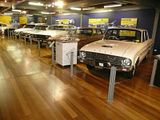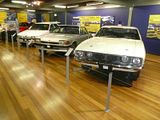Ford have been producing cars in Geelong, a town approximately 50 km to the west of Melbourne since 1925, so it seemed fitting to open a centre to showcase not just this long history, but also to inform on some of the technology that goes into the modern car. The Ford Discovery Centre, a joint venture with adjoining Deakin University, was opened in 1999, and is located in the middle of the town, in a building opposite the site of the first Ford Australia plant, and where Deakin University’s campus is now to be found. It is very easy to find, and there is ample street parking available right outside. On a wet morning, I went to go and investigate.The museum is split over 2 floors, and is well laid out. There is plenty to see, but the exhibits are not crammed in next to each other, and the lighting is good. This is not something that you can say about all museums! Although numerous Fords from the last 110 years of the marque form the core of the museum, there are plenty of other exhibits ranging from memorabilia to displays which inform on how a car is designed, built and how some of the technology works. Indeed, my visit was noisily joined by a large party of local school children who were clearly there to learn just that.
THE EARLIEST FORD
I never realised that Henry Ford’s first effort at creating wheeled transport took place as early as 1896. This is a replica of what he produced, a Quadricycle, in his shed at the rear of his house in Detroit. He designed and produced many of the parts himself, and the result had a top speed of 16 km/h, had 2 forward gears and no brakes. It was only when he was asked to produce several more such devices that he got serious about creating a company that ended up as the Ford Motor Company.
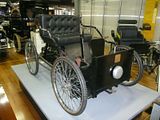 MODEL T
MODEL TThe Model T was popular in Australia for many of the same reasons as why it did so well in the US and other markets, selling over 30,000 examples. Almost all the cars were imported from the US, as it was only in 1925, the last couple of years of production, that Ford decided to set up their own manufacturing facility in Australia. Several examples of the “Tin Lizzie” are in the museum.
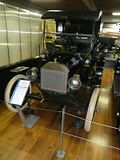
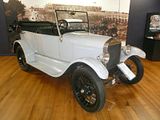
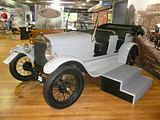
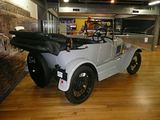
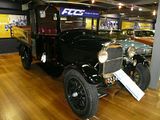
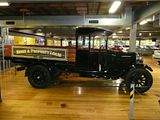
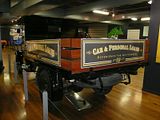 This is a Model A, that car that came next, and which also sold in significant quantities.
This is a Model A, that car that came next, and which also sold in significant quantities.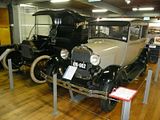
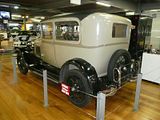 1930s
1930sNot content with riding on their laurels, and facing increasing competition from, among others General Motors. Ford surprised everyone in 1932 when they announced a V8 engine for their new car. Here are a couple of examples of that model, including a 1938 V8 Coupe..
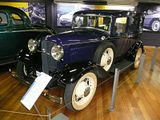

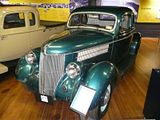
 Ford are very proud of this, the first Ute, more formerly known as the 1934 Coupe Utility. Conceived by a Geelong designer called Lewis Bandt, it was the result of a challenge received in a letter from a local farmers wife who wanted a working vehicle for Monday – Saturday that was smart enough to use to go to church on Sunday. The result was the first vehicle where a single steel body provided both the passenger compartment and the side of the load area. The rest, as they say, is history. Suffice to say that Utes remain extremely popular right across Australia.
Ford are very proud of this, the first Ute, more formerly known as the 1934 Coupe Utility. Conceived by a Geelong designer called Lewis Bandt, it was the result of a challenge received in a letter from a local farmers wife who wanted a working vehicle for Monday – Saturday that was smart enough to use to go to church on Sunday. The result was the first vehicle where a single steel body provided both the passenger compartment and the side of the load area. The rest, as they say, is history. Suffice to say that Utes remain extremely popular right across Australia.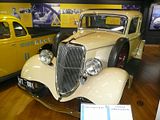
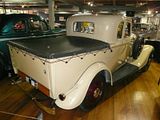 POST WAR PRODUCTS
POST WAR PRODUCTSThe Royal Automobile Club of Victoria took delivery of a number of these Anglia based Utes in 1950, which were a major advance on the motorcycles which had the means of transport used by patrolmen until that date. A further enhancement can in 1952 when a form of mobile telephone system was installed in the vehicles so it was no longer necessary for the patrolman to find a public payphone to call up for a recovery truck or assistance.
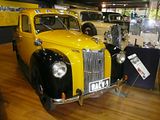
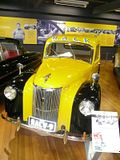
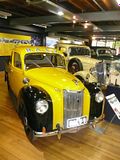

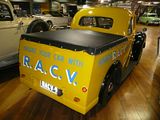 In the late 1940s and 1950s, Ford were largely selling British Fords on the Australian market, and examples of the sorts of cars that were offered included this trio of a 1948 Prefect, a later model 1958 Prefect and a 1952 Mark I Consul.
In the late 1940s and 1950s, Ford were largely selling British Fords on the Australian market, and examples of the sorts of cars that were offered included this trio of a 1948 Prefect, a later model 1958 Prefect and a 1952 Mark I Consul.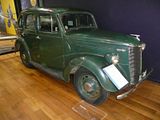
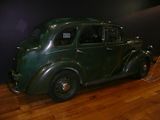
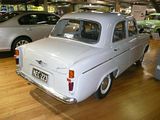
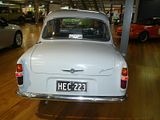

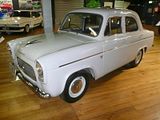
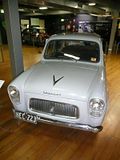


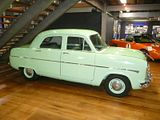
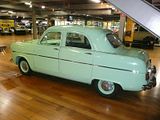
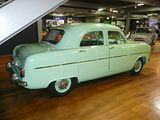 FALCON
FALCONFord in Australia really does mean Falcon, and the nameplate goes all the way back to 1960, when a locally produced version of the compact car that Ford in the US launched entered the market as Ford’s answer to the ever growing popularity of the locally designed and produced 6 cylinder Holden. This is the very first XK Falcon that came off the line in Geelong.
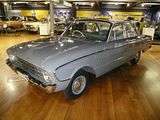
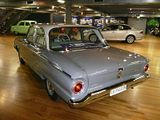
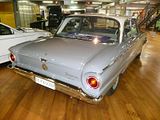
 The first cars proved not to be tough enough for the Australian market and it was not long before a revised XL model was launched. This is a 1962 example.
The first cars proved not to be tough enough for the Australian market and it was not long before a revised XL model was launched. This is a 1962 example.

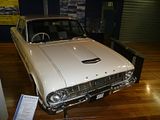
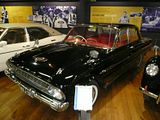
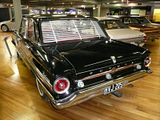
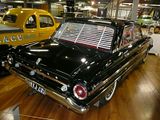 Mirroring the development of the US Falcon, a new and larger body design appeared in 1966, with the coke-bottle styling that was so popular at the time. This is a 1967 XR Falcon GT model.
Mirroring the development of the US Falcon, a new and larger body design appeared in 1966, with the coke-bottle styling that was so popular at the time. This is a 1967 XR Falcon GT model.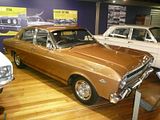
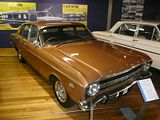 In 1970, Ford US ended production of the Falcon in favour of the new Maverick, but Ford Australia decided to keep going, by themselves and all Falcons since have been to their own local design. This one, an XB model, dating from 1973 shows the next major evolution of the body shape.
In 1970, Ford US ended production of the Falcon in favour of the new Maverick, but Ford Australia decided to keep going, by themselves and all Falcons since have been to their own local design. This one, an XB model, dating from 1973 shows the next major evolution of the body shape.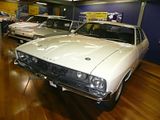
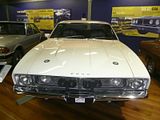
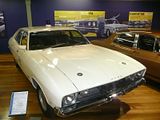
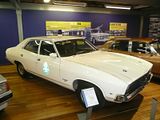 The XD came in 1979 and looked very much like the Mark 2 Granada that had been launched in Europe in September 1977, though the car was larger and the surfaces were a bit flatter. As is the way with Ford and Holden, frequent model updates make identifying the precise car a task for the expert., but helpful signage in the museum informed me that this was the slightly different XE model from 1982.
The XD came in 1979 and looked very much like the Mark 2 Granada that had been launched in Europe in September 1977, though the car was larger and the surfaces were a bit flatter. As is the way with Ford and Holden, frequent model updates make identifying the precise car a task for the expert., but helpful signage in the museum informed me that this was the slightly different XE model from 1982.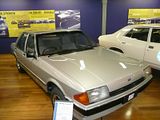
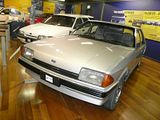 Falcon had long been popular as a wagon, and this is a prototype of the next generation again, the EA Wagon from 1986. It differs from the production cars in a number of very detailed respects.
Falcon had long been popular as a wagon, and this is a prototype of the next generation again, the EA Wagon from 1986. It differs from the production cars in a number of very detailed respects.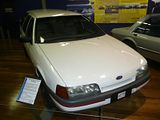
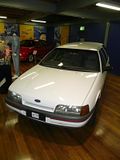
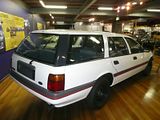
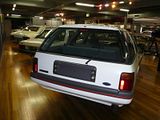 The AU cars were not terribly well regarded as the styling was seen as droopy. The unique front end to this high end XR8 model suffered even more than the regular models.
The AU cars were not terribly well regarded as the styling was seen as droopy. The unique front end to this high end XR8 model suffered even more than the regular models.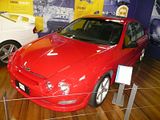
 The solution was the BA model which appeared in 2002 and this is a GT model from that year.
The solution was the BA model which appeared in 2002 and this is a GT model from that year.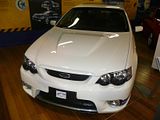
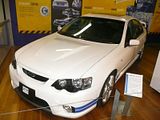 Almost as long as there have been Falcons, there have been all manner of enhanced performance models, and this rather vibrant green example of the current is in the foyer of the Discovery Centre.
Almost as long as there have been Falcons, there have been all manner of enhanced performance models, and this rather vibrant green example of the current is in the foyer of the Discovery Centre.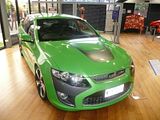
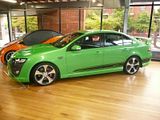
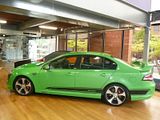
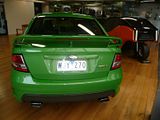 There is also a cutaway of the 2007 BF Falcon FPV F6 Typhoon performance car.
There is also a cutaway of the 2007 BF Falcon FPV F6 Typhoon performance car.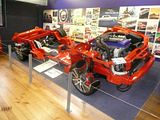 These two go back a bit further. One was a concept that was never productionised, but the other did go on sale and proved popular.
These two go back a bit further. One was a concept that was never productionised, but the other did go on sale and proved popular.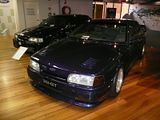
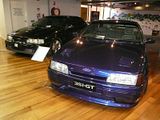

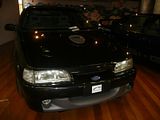 A brand new Series 2 FG Falcon G6E is included in the display.
A brand new Series 2 FG Falcon G6E is included in the display.
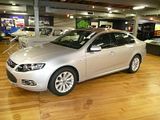
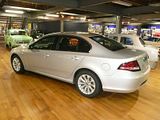
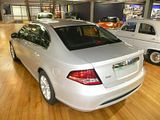
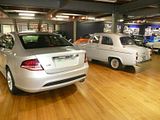 Once the basic Falcon was established, it was not long before customers sought a slightly bigger and more powerful car. Ford’s answer was the Fairlane, and this model evolved in parallel with the Falcon until recently when the nameplate vanished. This is a 1970 ZE Fairlane.
Once the basic Falcon was established, it was not long before customers sought a slightly bigger and more powerful car. Ford’s answer was the Fairlane, and this model evolved in parallel with the Falcon until recently when the nameplate vanished. This is a 1970 ZE Fairlane.

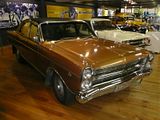
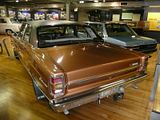
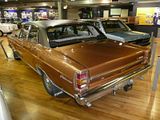 More luxurious still was the LTD. There is still plenty of ambiguity as to what LTD actually means, with Lincoln Type Design being the most widely held view. This is a 1982 car.
More luxurious still was the LTD. There is still plenty of ambiguity as to what LTD actually means, with Lincoln Type Design being the most widely held view. This is a 1982 car.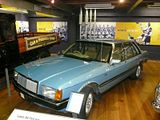
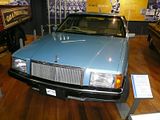
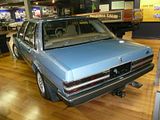
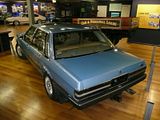 EUROPEAN and AMERICAN MODELS
EUROPEAN and AMERICAN MODELSLook closely at this 1973 Cortina and you will spot the large bonnet bulge. This was needed as the TC Cortina, as the car was called in Australia came with a choice of 2, 3 or 4 litre engines, and the bonnet bulge was needed to accommodate the larger engines that we never got in European cars.
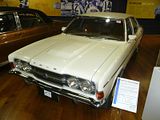
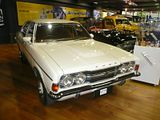
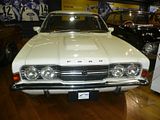
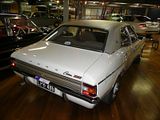
 A pair of European Capris, from early and late in the model’s life.
A pair of European Capris, from early and late in the model’s life.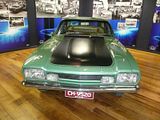
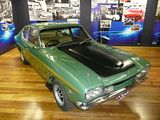
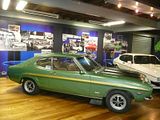
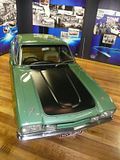
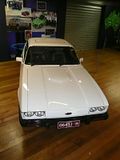
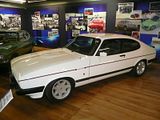
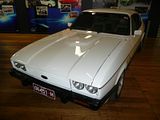
 The Capri nameplate was used again, when Ford produced this 2 seater sports car, based on Mazda mechanicals. A number were exported to the US, where the car had Mercury badges.
The Capri nameplate was used again, when Ford produced this 2 seater sports car, based on Mazda mechanicals. A number were exported to the US, where the car had Mercury badges.
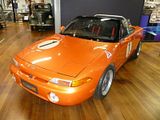 This Mustang Cobra was brought over to see if the car was suitable for the Australian market. It was decided that it was not.
This Mustang Cobra was brought over to see if the car was suitable for the Australian market. It was decided that it was not.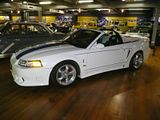
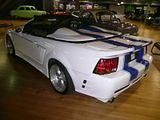
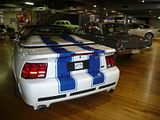
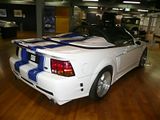
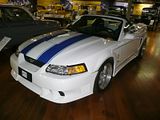 PROTOTYPES
PROTOTYPESThis might look like a Falcon, but in fact it is a mule for the SUV Territory model, and was used to assess aspects of the interior, and on road driving characteristics from the suspension and ride height without divulging anything of Ford’s plans for an SUV.
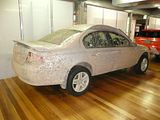 This R7 Show car looks very close to the production Territory, and was build to display at the 2002 Melbourne Motor Show to gain customer feedback. Although it looks quite convincing, it is a fibreglass and plastic shell based on an Explorer, unlike the production car which used adapted Falcon components.
This R7 Show car looks very close to the production Territory, and was build to display at the 2002 Melbourne Motor Show to gain customer feedback. Although it looks quite convincing, it is a fibreglass and plastic shell based on an Explorer, unlike the production car which used adapted Falcon components.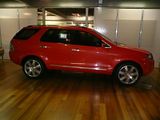
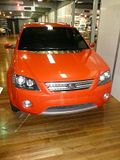

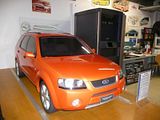 These clay models for the BA Falcon were produced some 3 years before production started and were used to finalise the styling details.
These clay models for the BA Falcon were produced some 3 years before production started and were used to finalise the styling details.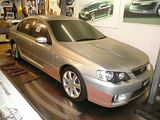
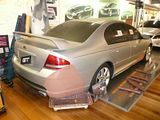
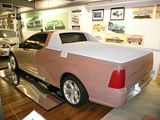
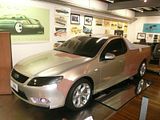
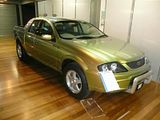
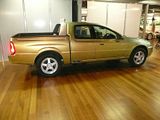 MOTOR SPORT
MOTOR SPORTThis restored Cortina was created as a replica of the first car owned by the V8 supercar racing driver Craig Lowndes. The work was done by local apprentices, under guidance and supervision from Craig himself, and the finished car is now used occasionally for historic racing events.
 At its launch, this was the fastest 4 door saloon available in the world. The XY Falcon GT HO Phase III has become a real cult car and survivors now are highly prized and highly priced.
At its launch, this was the fastest 4 door saloon available in the world. The XY Falcon GT HO Phase III has become a real cult car and survivors now are highly prized and highly priced.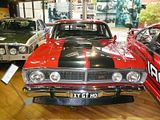
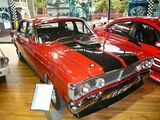
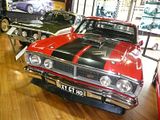 Antecedent to this car was an earlier XT Falcon GT which competed in the 1968 London to Sydney Marathon. Much to the chagrin of the Australians, it did not win (that honour went to the Hillman Hunter), but it did come third. Even finishing was quite an achievement.
Antecedent to this car was an earlier XT Falcon GT which competed in the 1968 London to Sydney Marathon. Much to the chagrin of the Australians, it did not win (that honour went to the Hillman Hunter), but it did come third. Even finishing was quite an achievement.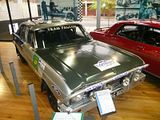
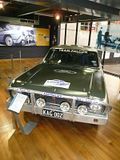
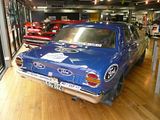 The Falcon is still active in motorsport, and this example is a recent car, adapted for use in drifting.
The Falcon is still active in motorsport, and this example is a recent car, adapted for use in drifting.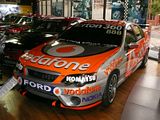
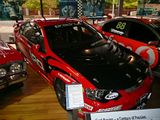 Ford technology is used in more obvious racing vehicles too, such as this Spectrum.
Ford technology is used in more obvious racing vehicles too, such as this Spectrum.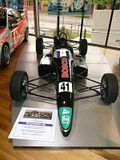 HOW A CAR IS MADE
HOW A CAR IS MADEA number of exhibits in the Discovery Centre are presented to show various facets of the modern car. from initial design concepts to how the body is created from what starts out as sheet steel, to crash testing, and how a number of individual components work. It is all very clearly presented.
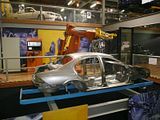

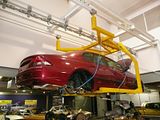
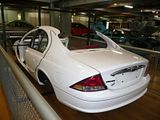
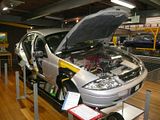
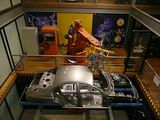 A number of cut-aways which had previously been used for Motor Shows, dealer training and other displays were also presented.,
A number of cut-aways which had previously been used for Motor Shows, dealer training and other displays were also presented.,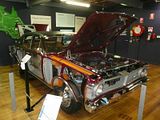
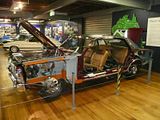

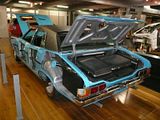
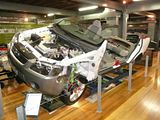
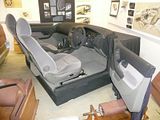 This line up of engines shows how very different in overall shape and design the various powerplants that Ford have used in the past few years have been.
This line up of engines shows how very different in overall shape and design the various powerplants that Ford have used in the past few years have been.
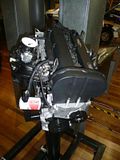


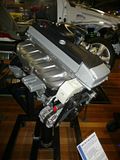
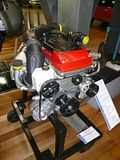 EVERY DECADE IN A GLASS CASE
EVERY DECADE IN A GLASS CASEA splendid set of glass cases containing models and other period memorabilia covered most of the decades from the 1930s to the 1990s.
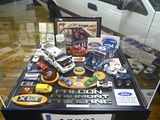

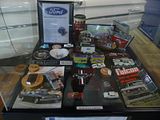 THE FUTURE?
THE FUTURE?This was the creation in a competition launched to celebrate Ford’s centenary, for university students to come up with a future vehicle design, as a Model T Ford for the 21st Century. This one was proposed by students at the neighbouring Deakin University.
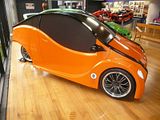 Designing a car costs ever more money, and as the Falcon is only sold in Australia and New Zealand, it would appear to be facing an uncertain future. Literally days before I arrived in Geelong, a “survival plan” had been agreed which guarantees the continued existence of the car for at least 4 years and with it the huge manufacturing plant that is elsewhere in the town. To say that the locals were relieved is something of and understatement.
Designing a car costs ever more money, and as the Falcon is only sold in Australia and New Zealand, it would appear to be facing an uncertain future. Literally days before I arrived in Geelong, a “survival plan” had been agreed which guarantees the continued existence of the car for at least 4 years and with it the huge manufacturing plant that is elsewhere in the town. To say that the locals were relieved is something of and understatement.An absorbing place, and an excellent way to escape the Melbourne rain. More details can be found at the museum’s own website: http://www.forddiscovery.com.au/
2012-04-05 17:55:11



















































































































































